|
English Creek: a smart mill stream
of Great Egg Harbor Township, Gloucester County
which flows by a southwest course of 4 or
5 miles into Great Egg Harbor River, about
5 miles from the Bay....
...Gazetteer
of New Jersey by Thomas Gordon, 1838.
|
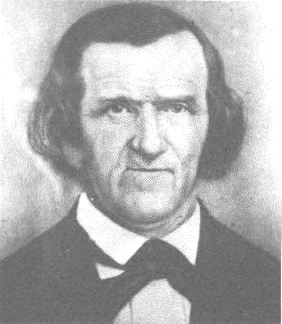
John English (1690 - 1770)
A photo copy
of the 2" x 2" black
and white portrait in the home
of Andrew R. English.
by
Joseph Henry Bennett
|
|
John English (1690-1770)? was the son of
Joseph and Hannah (Clift) English of Burlington
N . J. In 1714 John English received large
tracts of land at English Creek where he settled,
and had extensive sawmills. The maiden name
of his wife Sarah is not known. He served
as a Justice of the County Courts. He was
active in the early religious societies in
Great Egg Harbor.
Joseph English (1812-1889) was the son of
James and Mary (Lake) English of English Creek.
He married Ann West Smith (1816-1900) a daughter
of Constant and Eunice (Somers) Smith of Scullville.
He was a farmer and lived on the west side
of English Lane in English Creek. He served
as one of the first trustees of Asbury Methodist
Church in 1852.
He was the grandfather of Andrew Robinson
English, who lives across the Lane from the
old J. English homestead.
ENGLISH CREEK
Winter came late to the New Jersey country
side in the year 1874. The village of English
Creek, nestling along side the Great Egg Harbor
River; which leads to the Atlantic Ocean;
was humming with its varied activities. For
English Creek was a growing community and
its residents were enthusiastic as to its
potential.
On a cold December day, Israel Smith, boat
builder, watched a boat built for John E,
Smith, launched from the dock at the English
Creek Boat Yard. It was a sturdy vessel with
120 foot keel. As the vessel slowly proceeded
down the creek, Israel pulled a small worn
black book from his pocket and wrote: "Dec.
22, 1874 - Launched vessel, The EvaI Smith".
As he thumbed thru the pages, he thought,
"Thank Goodness, this one went smoothly
- the tides and wind just right - not like
"The Elizabeth F. Cottingham" -
We launched her in January. Took us 'till
March to move her to the wharf - yes, here
it is.'? Jan. 7, Cut trees for launching and
ways from Joseph English. - Launched vessel
Jan.3Oth - and finally moved her to the wharf
on March 6th. Settled for schooner, Elizabeth
F. Cottingham, March 13th and on March 22
she went to sea.
"Now the building of the 'Eva I Smith'
sure went slow - made the model Feb. 9th,
then cut and carted logs to the mill Feb.
11th. Started actual building Feb. 20th. During
April the ground was frozen hard and the creek
partially frozen over. Hauled out the keel
for the vessel on April 13th. We sure had
a slow start. Yes, that was the month Captain
John Jeffers, of the schooner L. A. Rommil,
stopped to visit. It's nice to see old friends.
Told him Japhet Champion went to sea on Feb.
4th and William Jeffers was elected overseer
of roads on March 7th. - also Thomas Bevis
died April 9th, - poor man, he'd been confined
to bed for six years."
"In May it turned real warm - that was
good for the crops - and we had quarterly
meeting at Asbury Church, May 2nd. Agreed
to pay the preacher $800.00 - hope it's not
too much. The exhibition at the Hope School
was a success on May 19. And yes, hereon June
2nd, the Schooner A. M. Baily delivered lumber
to the boat yard. On June 30th, I drew up
papers for John B. Ingersoll for a vessel
to be built by Elisha V. Alby."
"During July and August we mowed salt
hay and loaded it on scows." Drought
prevailed and the corn suffered; finally got
a shower on August 7th."
"August 21st - "My birthday - I'm
55 years old and feeling like I'm going downhill."
Could be - I'm beginning to slow down. Oh
well."
"English Creek is really growing tho,
and we all have high hopes. Our roads have
sure improved. I've made two agreeable trips
to Jamestown and Yorktown, Virginia this year;
to purchase lumber from Wolfs Mill for the
shipyard. Have to start building a Schooner
for Enoch Smith - I better stop looking back
and look forward."
The Settlement
|
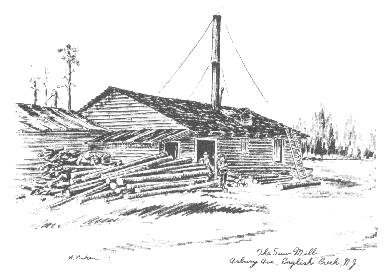
The steam saw mill located on
the northeast intersection of
Asbury Avenue and Zion Road, in
English Creek was built in 1904
by Oliver A. Lee, George Lee and
Samuel Ireland.
It was torn down some years ago.
The land is now owned by the Asbury
Methodist Church.
|
|
Thomas Gordon, writing a history of New Jersey
in 1834, said that English Creek was a "smart
mill stream of Egg Harbor Township which flows
by a southwest course of four or five miles
into Great Egg Harbor River, about five miles
from the sea."
A grist mill was built a few miles up the
creek and later a saw mill utilized the power.
A settlement grew up and that, too, was called
English Creek after the English family who
first settled there in 1714.
As more families moved into the area, the
demands of daily living, progressed with the
age until by the middle and latter part of
the 1800's a church, school, post office and
store were firmly established. Also a saw
and grist mill, a ship building yard, a blacksmith
shop and a tavern.
In addition there were farm products to be
sold or traded, forest products, charcoal
making, salt hay to be harvested, fish and
shell fish, game from the forests; and following
the sea itself.
|

The Grist and Saw Mill on Aaron
Somers Mill Pond on Zion Road
in English Creek.
Names left to right: Lewis Smith,
Alfred Scull & Emma Smith,
Caroline S. Smith in doorway,
and Christopher Lake English (1844-1917)
son of Joseph and Ann W. (Smith)
English. Father of Andrew R. English
in English Creek.
|
|
Forest Products
A large part of English Creek was covered
by pine forests along with oak, chestnut and
maple. For one hundred and fifty years many
of the inhabitants depended principally on
forest products of one kind or another for
their livelihood; but comparatively, lumber,
charcoal and other marketable products.
Charcoal
The pine forests a few miles back from the
river supplied the material for making charcoal.
An experienced wood chopper could cut two
cords of wood a day and the standard pay for
years was twenty-five cents a cord.
The wood was carted by horse and wagon to
a cleared spot, usually a slight depression,
caused by successive burning of vegetation.
A small tree was used for a center pole with
four-foot lengths of cordwood, two tiers high,
stacked against it to form a teepee shaped
mound. Over this was placed turf; out from
the surrounding ground with a turfing hoe.
From four to six inches depth of sand covered
the mound. About eight cords of wood were
required for a pit.
To fire a pit, the center pole was pulled
out, and a fire started at the top; allowed
to drop to the bottom of the hole and fed
with short lengths of wood. When this was
burning satisfactorily the hole at the top
was covered with the turf and sand and a draft
hole made at the bottom, to regulate the amount
of air entering, so the wood charred instead
of burning to ashes.
The "burning" took from eight to
ten days. As the wood charred, the pit became
smaller, eventually "falling in".
The draft was cut off, turf and sand raked
away, and the charcoal allowed to cool. It
was then broken into pieces, loaded in baskets
and bags, and hauled to the wharf for shipping.
Cordwood
Great cargoes of cordwood were shipped on
coastwise steamers from English Creek Wharf
and Betsy Scull Wharf. Most of it was sent
to Haverstraw, New York, where it was used
in the manufacture of bricks. The schooners
returned with a load of bricks.
Shipbuilding
Shipbuilding was one of the industries, which
engaged many of the men of English Creek.
Two and three mast schooners were built from
the lumber taken from the forests in and around
the surrounding area.
The boat yard, located on English Creek,
was ideally suited for building and launching.
Israel Smith (1819-1885), one of the builders,
would first draw up "papers" for
the owner, then build a model of the contracted
vessel; before actual construction began.
Captain John J. Blackman remembered these
ships built at the English Creek Yard by Israel
Smith.
|
Schooner Somers M.D. Scull
Schooner Addle N. Haines
Schooner C . L. Scull
Schooner E .T. Cottingham
Schooner Eva I. Smith
|
— Captain Zephenor
Steelman
— Captain Lamer Blackman
— Captain David Scull
— Captain John Smith
— sold to John Saunders |
In addition to building boats, Israel Smith's
knowledge and aid were solicited in tiles
of trouble at sea. On November 30th, 1877,
he was called to Georgetown to free a schooner
from a sandbar, the St. Cave Edwards, in charge
of a Captain Ireland. It had run aground.
This took twelve days and before he returned
to English Creek, he visited the House of
Congress, the U.S. Senate, the Smithsonian
Institute and the Robert E. Lee mansion.
|
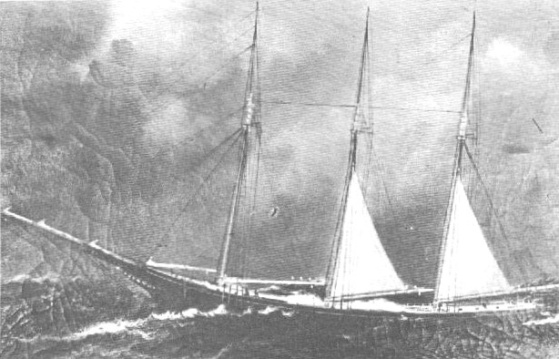
SCHOONER: Emma L. Cottingham
Built in 1875 at Somers Point
3 masted schooner
522 Tons
139' 4" length
34' beam
10' 2" deep
J. B. Steelman Owner
In 1875 Somers Point was in the
Township of Egg Harbor. Israel
Smith, shipbuilder of English
Creek was engaged in the Yard
located there. Oil Painting courtesy
of Mrs. Edgar Somers.
Photo by William Hann
|
|
Following the Sea
Many of the men and women of this early period
in our history followed the sea. Wives were
left to care for the farms and rear the children.
John J. Blackman (1852-1938) was born in
English Creek. He lived here with his parents
until he was thirteen years of age. He then
started to sea, sailing on various vessels
as cook and then as sailor before the mast.
At sixteen he was made mate of the schooner
"Althea" sailing in general coast
trade. In this service he became a navigator
and boasted that he could find his position
at sea whenever the sun was shining.
Blackman soon became Captain of his own ship
and owned a number of vessels until he retired
in 1888 to a farm in Steelmanville.
Many of the boys and men who went to sea
never returned. A few monuments in the cemetery
have the legend, "Lost at Sea".
It is easier to understand the risk involved
in shipping in those days of sailing vessels,
when we consider some of the local vessels
lost at sea.
Schooner Theresa Wolfe - built for Captain
John Lee of English Creek in 1875 - Foundered
in a heavy gale while lying at anchor in
Delaware Breakwater.
Schooner Eliza S. Lee - built for Captain
John Lee of English Creek - Lost at sea
off east coast.
Schooner John B. Clayton - built for Captain
John Clayton of English Creek in 1862 -
wrecked off the coast in a storm.
Schooner Rebecca A. Tulane - built for
Captain Japhet Champion of English Creek
in 1882 - Abandoned at sea off Cape Hatteras.
Salt Hay
All the meadowland along the tidewater produced
a salt hay, which was in demand for bedding
livestock, especially in city livery stables
and for one short period as the raw material
for the Harrisville paper mill in Burlington
County, northeast of Batsto.
Many farmers had a hay mower and rake drawn
by horses. There was great competition for
the leasing of meadow land for the hay on
both sides of the river. Horses and machinery
were rowed over on large hay scows. Horses
had to wear "mud boots" made of
leather, to keep them from getting mired.
Some haying crews mowed by hand with scythes.
Small hay-cocks were raked together and two
men lifted them on scows by the means of two
poles thrust under the pile. When the scow
was loaded to capacity, the crew waited until
the tide was right and with heavy oars, rowed
the boat to one of the available wharfs for
shipping.
Farming
Some men farmed for a living, but no matter
what a man's trade, he always managed to do
enough farming to supply his family with food
during the summer and to put away sufficient
for the winter. Root vegetables, cabbages,
and apples were stored in a cellar or cave;
other fruits and vegetables dried; and meat
and some vegetables preserved by brine method.
In early October the molasses mill was set
up for processing sorghum. Buckwheat, wheat,
oats, and corn were carted to the mill to
be ground into flour products. The miller
often took a share of the flour for grinding
it, keeping it for his own use and selling
the surplus.
Almost every family had livestock; a flock
of hens, geese, ducks, turkeys, pigs, a cow,
horses for farm work and transportation, and
perhaps a calf for butchering.
During the latter part of the 1800's, the
families whose livelihood depended on farming
found a ready market for their livestock,
hay and grain at Weymouth. Hides were sold
in Egg Harbor to a shoe factory that was in
operation there. A hired "hand"
received $10.00 a month.
Current prices at that time were:
| |
Beef
Veal
Chickens
Turkey |
l0¢ per pound
l4¢ per pound
14 l/2¢ per pound
16¢ per pound |
Country Store and Post Office
In the earliest days most trade was done
by barter. Farmers were independent in an
economic sense because there were few necessities
that they could not provide.
Seamen went out and came back with currency;
farmers learned that larger towns afforded
a ready market for crops. The country man
gradually became dependent on his fellowman
and general stores sprang up all over the
country.
The supplies handled by these stores were
geared to the demand of their particular location.
During the middle of the eighteenth century,
post offices were located in the stores. The
position of postmaster was most coveted because
it naturally increased trade at the chosen
store.
Audubon and Wilson
Two of America's greatest ornithologists
found the Great Egg Harbor and River with
its coves and creeks to be the habitat of
the birds they wanted to paint.
In 1813, Alexander Wilson came to the river
to study water birds while working on the
eighth volume of his great work. He contracted
a cold, from a fall in the river near Somers
Point and died in Philadelphia, August 23,
1813. Before his death he stated, "many
a drawing I made at Egg Harbor River and many
a pleasant day I spent along its shores."
John James Audubon made a trip to the Great
Egg Harbor River in 1828, traveling with a
group of hunters and fishermen, exploring
English Creek and the nearby salt marshes.
He painted tern, heron, marsh hens, and sea
gulls; re-drawing many of his earlier water
birds; the sea finch with wild roses-, the
yellow breasted chat, and the black poll warbler.
In a few weeks he had completed thirteen paintings
and had made some sketches.
Methodists - Religion
|
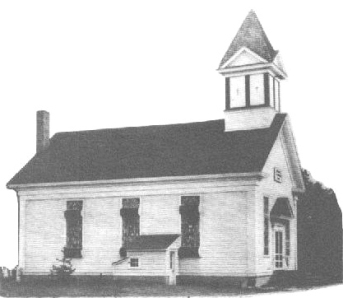
Asbury Methodist Church
The Asbury Methodist Church was
erected in 1852 some 100 feet
west of the English Meeting House.
This church was destroyed by fire
in December of l860. The church
was rebuilt in 1863.
photo J.H. Bennett 1963
|
|
As America was founded on religion - so,
too, did religion influence the early beginnings
of English Creek.
Methodism in English Creek reaches to the
preaching of the first riders of the Salem
and Bethel Circuits in 1789-1803 and to the
preaching of the first Bishop of the Methodist
Church in America - Francis Asbury.
The first preaching in English Creek was
at the homes of Joseph Inglishes (English)
and David Blackman, stations on the two circuits.
By the years 1790-96, the two classes had
formed a society. The first Methodist revival
occurred in 1796. The results of the revival
in the Creek was the building of the English
Creek Meeting House. This was located in the
rear of the present Asbury Methodist Church
just west of the large cedar and north of
the privies.
This church was unlighted. Many worshippers
brought light with them, and as the congregation
gathered, they would place their candles on
the beam across the Church; thus affording
light for all.
In 1852 the first Asbury Methodist Church
was built, upon the site of the present church.
Fire destroyed this church on Christmas Eve,
1860. The present church is standing on the
same foundation. On one cornerstone is 1852;
on the other 1863. Joseph Endicott Smith was
the builder of this church and Rev. Edward
Waters served as first minister.
Conclusion
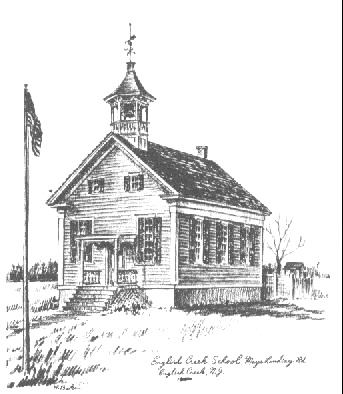
English Creek School
The old English
Creek School House at the southeast
corner of Zion Road and the
Somers Point to Mays Landing
Road. It was built in the 1850's.
|
|
On October 20th, 1963 - Andrew English of
the seventh generation of the founders of
English Creek, strolled briskly from his front
door to the large oak tree standing in front
of his home on English Lane. It was a beautiful
day - clear and with just a nip in the air.
As he stood beneath the wide spreading branches,
he looked up at this majestic tree and thought:
"If only you could speak, oak tree,
you've been standing here since 1664. You
could tell us of the many changes that have
come to this community. I remember many and
my folks have told me of others.
I graduated from the school, which still
stands, at Zion and Mays Landing-Somers Point
Road, in 1902. It's a private dwelling now.
It was built in 1850 and discontinued in use
during the 1930's. I know of two other schools
before that. One in the back of the house
owned by Art Hanson on Zion Road; the other
near the' house owned by the Douglass family
on Mays Landing-Somers Point Road. An old
trail still leads back to that site. They
were in use in the early 1800's.
Now we have a modern Junior High, the H.
Russell Swift School on Ocean Heights Avenue."
|
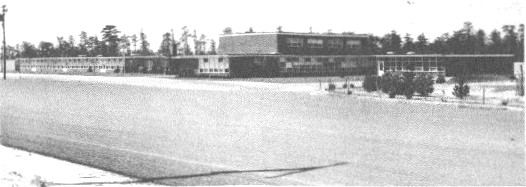
H. Russell Swift School
On Ocean Heights Avenue, Egg
Harbor Township, erected in 1956.
- photo by Dan F. Cox.
|
|
And across from Harry Scull's service station,
William R. Lake had his blacksmith shop in
1885. Before that his shop was at the triangle,
formed by Asbury and Zion Roads. Garages and
service stations have replaced that trade.
And the Mills; both the grist and saw mill;
located in back of Asbury Church at the present
Hogan home. The pond there was Aaron Somers
Mill Pond, and The mills were in operation
in 1800.
Instead of a post office, located in a general
store, we have rural delivery. This began
in the early 1900's and at that time the mailbox
had to be mounted on tall posts to accommodate
the high wagons used for delivery. The post
office I remember was located in Henry Scull's
Store on English Creek Avenue near Mays Landing
- Somers Point Road. Our present Mays Landing-Somers
Point Road was built in 1914.
Across the road stands the house of my grandfather,
Joseph English, built in 1838; and my house
was built in l882 by Joseph Endicott Smith,
the builder of Asbury Church.
Hmmm, today is a day for remembering. We're
celebrating "Home coming" today
at Asbury Church; its 100th anniversary. Well
I better stop looking back and get ready for
the church."
Yes, we the people of English Creek, both
the "newcomers" and the natives
have a wonderful heritage, and we too have
our share in the making of history.
Credits:
Thesis and research Ann Nickles - Margaret
Hart
Journal of Israel Smith (1819-1885) Covering
1874, 1877, 1883, 1885.
Research, maps, books and other data Joseph
Henry Bennett
Interviews with Andrew R. English
|







